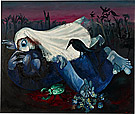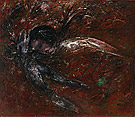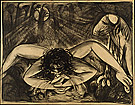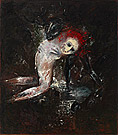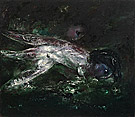Exhibition themes Reflected bride + Floating nude
Bride And Floating Nude Series
About thirty works make up Boyd’s extraordinary series Love, marriage and death of a half caste, commonly known as his Bride paintings. While the core group of these paintings were completed in Melbourne between 1957 and 1959, their origin can be traced to the artist’s journey to Central Australia earlier in the decade. Lured by the idea of painting the vast landscape of the interior, he travelled to the former gold mining town of Arltunga in the Simpson Desert.
In sketchbooks, Boyd recorded aspects of the landscape but his attention was increasingly drawn to its Indigenous inhabitants who had been dispossessed by the advance of colonisation and inhumane assimilation policies of the 1930s. Among the images that struck him were Aboriginal brides on a truck dressed in wedding finery. He was shocked and troubled by the conditions he witnessed during this trip: ‘I was amazed that in 1951 no one seemed concerned’. Over time the Bride series increasingly also expressed a broader sense of empathy, love and the struggle of relationships.
In the early 1960s, after the death of his mother Doris, Boyd produced the darker atmospheric Floating nude paintings with embracing figures suspended in space. These works provide a contrast to the Bride series in their less graphic, more fluid portrayal, while continuing to explore ideas of relationships: love, desire, loss and renewal. The painterly surface of these works, inspired by Titian’s Diana and Acteon 1556–59, compliment the layers and glazes of the ceramics in this room.







